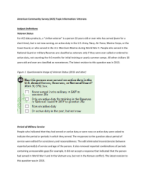Veterans Glossary
Veterans Glossary
The glossary below may define terms not included in the main Glossary on census.gov
The main Glossary on census.gov provides official definitions covering all topics, censuses, surveys and programs.
To begin a search, enter a term or acronym in the search bar or click the letter to see all the terms that begin with that letter. Click view to see the definition for a term. You may select one or more terms to place them in the Selected Terms box for downloading or printing. Click on Printable View to preview the page.
Who are veterans?
Veterans are men and women who have served (even for a short time), but are not currently serving, on active duty in the U.S. Army, Navy, Air Force, Marine Corps, or the Coast Guard, or who served in the U.S. Merchant Marine during World War II. People who served in the National Guard or Reserves are classified as veterans only if they were ever called or ordered to active duty, not counting the 4-6 months for initial training or yearly summer camps.
While it is possible for 17 year olds to be veterans of the Armed Forces, ACS data products are restricted to the population 18 years and older.
For more information about definitions of veterans’ topics on the American Community Survey, see American Community Survey Topic Information: Veterans.
What is active duty?
Active duty military service includes full-time service, other than active duty for training, as a member of the U.S. Army, U.S. Navy, U.S. Air Force, U.S. Marine Corps, U.S. Coast Guard or as a commissioned officer of the Public Health Service or the National Oceanic and Atmospheric Administration, or its predecessors, the Coast and Geodetic Survey or Environmental Science Service Administration. Active duty also applies to a person who is a cadet attending one of the five United States Military Service Academies. Active duty applies to service in the military Reserves or National Guard only if the person has been called up for active duty, mobilized, or deployed. Service as a civilian employee or civilian volunteer for the Red Cross, USO, Public Health Service, or War or Defense Department are not considered active duty. For Merchant Marine service, only service during World War II is considered active duty, and no other period of service.
What are periods of military service?
People who indicate that they had ever served on active duty in the past or were currently on active duty are asked to indicate the period or periods in which they served.
Currently, there are 9 periods of service on the American Community Survey, Current Population Survey, and Survey of Income and Program Participation questionnaires. Respondents are instructed to mark a box for each period in which they served, even if just for part of the period. The periods were determined by the Department of Veterans Affairs and generally alternate between peacetime and wartime.
What is a service-connected disability rating? (Collected on ACS and CPS veteran supplement)
The Department of Veterans Affairs (VA) evaluates veterans with a variety of disabling conditions after they are discharged from military service. A "service-connected" disability means the disability was a result of a disease or injury incurred or aggravated during active military service. The VA uses the Schedule for Rating Disabilities in Title 38, U.S. Code of Federal Regulations, Part 4 to assign ratings. These ratings are graduated according to degrees of disability on a scale from 0 to 100 percent, in increments of 10 percent. The ratings determine the amount of compensation payments made to the veterans. A zero-rating, which is different than having no rating at all, means a disability exists but it is not so disabling that it entitles the veteran to compensation payments.
Service-connected disability ratings are not necessarily correlated with having a disability, as defined by the ACS questions. Veterans can receive a service-connected disability rating for a variety of conditions. Caution should be used when trying to correlate the two concepts using ACS data.
For more information about service-connected disability status and ratings, see:
Working Paper
Working Paper






